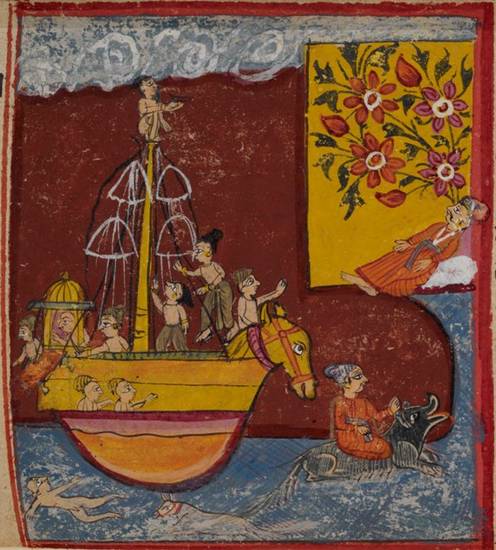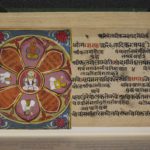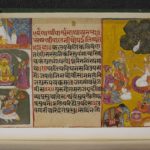Article: Āyambil Oḷī
Āyambil Oḷī refers to both a twice-yearly festival and the fast associated with that festival. The nine-day festival takes place in the spring and autumn and is marked by a fast for the length of the festival. Daily activities are a feature, especially sermons in the autumn Āyambil Oḷī.
Strongly connected with married women, the Āyambil Oḷī festival revolves around the veneration of the siddhacakra and the story of Śrīpāḷ and Mayṇāsundarī. Jains believe that the fasts and associated rites foster happiness in married life and good health for all the family, particularly regarding preventing and healing skin diseases.
Festival of Āyambil Oḷī

Siddhacakra
Image by British Library © CC0 1.0 (Creative Commons Public Domain)
Each year the Āyambil Oḷī festival falls in the spring during Caitra bright 7 to 15 and in the autumn during Aso bright 7 to 15. The autumn festival is celebrated by more people, in part because at that time of year Jain mendicants frequently stay near local communities during the rainy season retreat.
Principal themes of the Āyambil Oḷī festival are marital happiness and the good health of all the family. It focuses on religious practices and goals associated primarily with married women, such as the practice of fasting. Therefore it is almost exclusively married women who take part in and concern themselves with this festival.
The Āyambil Oḷī festival is strongly linked to the narrative of Śrīpāḷ and Mayṇāsundarī, the worship of the siddhacakra yantra and the recitation of the Navkar-mantra. Sermons on each of these elements are characteristic of the festival, particularly in the autumn.
Sermons on the siddhacakra
The siddhacakra yantra is a symbolic representation of the nine things worthy of worship in the Jain tradition. Each of the nine days of the festival is strongly related to one of the nine points on the siddhacakra. Mendicants often structure their sermons to reflect on the particular part of the siddhacakra being venerated on that day. For example, the first position is Arhat – the enlightened ones – and the sermon on that day might focus on the nature of the arhats.
Sermons on the Navkar-mantra
The siddhacakra is the visual form of the Navkar-mantra. Most Jains recite this mantra daily and it is considered a key Jain religious practice. If there is a mendicant in residence, he will give a daily sermon about the power of the Navkar-mantra and retell the Śrīpāḷ and Mayṇāsundarī story.
Tale of Śrīpāḷ and Mayṇāsundarī

Śrīpāla’s adventures
Image by British Library © CC0 1.0 (Creative Commons Public Domain)
Jain ascetics often give the example of Śrīpāḷ and Mayṇāsundarī when they deliver a sermon on the siddhacakra. They concentrate on Mayṇāsundarī’s performance of the Navpad Oḷī Fast, which leads to the miraculous healing of Śrīpāḷ’s leprosy.
This narration echoes the preoccupation of the festival, which is marital happiness. It does not reproduce the structure of the epic – Śrīpāḷ Rājāno Rās – from which it is drawn, which includes many episodes tracing Śrīpāḷ’s adventures after he is healed.
Fasting
A major element of the twice-yearly Āyambil Oḷī festival is the fast, of which there are three types. Fasting is accompanied by a structured series of additional devotional and ascetic practices, including twice-daily confession, extensive temple worship focused on the siddhacakra yantra, recitation of the Navkar-mantra and study of the Śrīpāḷ and Mayṇāsundarī narrative.
Each day the participants gather for the better part of the afternoon to eat their single meal together, to study the story of Śrīpāḷ and Mayṇāsundarī and to perform the evening confession as a group. This sociability contrasts with the ascetic nature of these practices and, in this case, the tasteless food.
Generally, this fast is seen as a married women’s fast. While there are men who perform occasional, single-day āyambil fasts they virtually always do so at the behest of their wives. This almost imitates Śrīpāḷ’s performance of siddhacakra worship after his wife Mayṇāsundarī convinces him.
Types of fast
Within the Āyambil Oḷī fast complex, there are three related fasts. Each suggests varying degrees of commitment, but all are understood to aim at the shared goal of well-being of the family. The fasts differ primarily in terms of their length:
- a single āyambil fast
- the nine-day Āyambil Oḷī
- the Navpad Oḷī, which is a series of nine āyambil olīs.
An āyambil fast is a one-sitting fast involving the eating of only tasteless foods. It is therefore more of a restriction on diet than a fast as it is generally understood. The fact of the lack of taste, of course, makes the austerity of an āyambil fast substantially greater than a one-sitting fast of regular food.
Āyambil fasts are predominantly performed during the biannual nine-day Oḷī festival, but are also performed on those days where fasting is a requirement for Jains. Many mendicants take nearly constant āyambil vows. Lay Jains will sometimes take an āyambil vow so that mendicants can receive alms at their house.
Oḷī means ‘a line’ and the Āyambil Oḷī fast is a line of nine days of āyambil fasts performed back to back during the Āyambil Oḷī festival.
The Navpad Oḷī is a series of nine consecutive nine-day Āyambil Oḷīs performed during the spring and autumn Āyambil Olī festivals. This results in 81 days of āyambil fasting over four and a half years.
Religious importance of the fast
Jains believe that the vows of fasting, together with the twice-daily confessions and the worship of the yantra, reduce the flow of karma into the performer’s soul and destroy her existing karma. They are also powerful forces that help protect the health of the performer’s family, especially her husband, through a transfer of merit or through magical agency.
Effects of Āyambil Oḷī
Traditionally, Jains believe that the āyambil fast and the worship of the siddhacakra, especially during the Āyambil Oḷī festival, promote marital happiness and the healing of skin diseases. The protection of general good health for all the family is another traditional benefit. These claims are drawn directly from the Śrīpāḷ and Mayṇāsundarī story.
Jains’ confidence in the effectiveness of the various āyambil fasts in worldly matters may arise from the siddhacakra worship as presented in the tale of Śrīpāḷ and Mayṇāsundarī and the other rituals associated with the fasts. It is vital to recall that the siddhacakra serves as both a powerful mantra and a yantra. In addition, Jains believe that both the siddhacakra and the Navkar-mantra it illustrates have magical powers. A Jain can harness these powers by reciting the mantra and worshipping the siddhacakra. The mantra is said to have the following powers:
- to protect the chanter from harm
- to counteract the negative effects of making contact with inauspiciousness
- to stand in for all other ritual utterances.
Jains often bless themselves with the water used to bathe religious icons or symbols used in daily or special worship, which they believe can prevent and cure skin diseases. However, Jains do not think that the water has gained its sacred powers from the Jinas because honouring them in rites of worship does not include expecting favours to be granted. Instead, Jains consider that this water has got its powers from flowing over the magical siddhacakra.
Thus there are connections between the tantric powers of mantra and yantra, as expressed in a Jain context through the siddhacakra, and the worldly effectiveness of a fast. The magical power of the yantra allows the fast to work on a worldly level while the fast also works on the level of karma reduction at the same time.
Reading
- Absent Lord: Ascetics and Kings in a Jain Ritual Culture
Lawrence A. Babb - Comparative Studies in Religion & Society series; volume 8
University of California Press; Berkeley, California, USA; 1996
- Organizing Jainism in India and England
Marcus Banks - Oxford Studies in Social and Cultural Anthropology series; volume 3
Clarendon Press; Oxford, UK; 1992
- Jains in the World: Religious Values and Ideology in India
John E. Cort - Oxford University Press USA; New York, USA; 2001
- The Archetypal Actions of Ritual: A Theory Illustrated by the Jain Rite of Worship
Caroline Humphrey and James Laidlaw - Oxford Studies in Social and Cultural Anthropology series
Clarendon Press; Oxford, England UK; 1994
- Singing to the Jinas: Jain Laywomen, Maṇḍaḷ Singing and the Negotiations of Jain Devotion
M. Whitney Kelting - Oxford University Press USA; New York, USA; 2001
- ‘Negotiating Karma, Merit, and Liberation: Vow-taking in the Jain Tradition’
M. Whitney Kelting - Dealing with Deities: The Ritual Vow in South Asia
edited by Selva J. Raj and William P. Harman
State University of New York Press; Albany, New York, USA; 2006
- Heroic Wives: Rituals, Stories and the Virtues of Jain Wifehood
M. Whitney Kelting - Oxford University Press USA; New York, USA; 2009
- Riches and Renunciation: Religion, Economy and Society among the Jains
James Laidlaw - Oxford Studies in Social and Cultural Anthropology series
Oxford University Press; Oxford, UK; 1995
- Honour, Nurture and Festivity: Aspects of Female Religiosity amongst Jain Women in Jaipur
Josephine Reynell - PhD dissertation submitted to University of Cambridge in 1985
- ‘Women and the Reproduction of the Jain Community’
Josephine Reynell - The Assembly of Listeners
edited by Michael Carrithers and Caroline Humphrey
Cambridge University Press; Cambridge, UK; 1991
- ‘Religious Practice and the Creation of Personhood among Śvetāmbar Mūrtipūjak Jain Women in Jaipur’
Josephine Reynell - Studies in Jaina History and Culture: Disputes and Dialogues
edited by Peter Flügel
Routledge Advances in Jaina Studies series; volume 1
Routledge Curzon Press; London, UK; 2006
Links
- Story of Śrīpāḷa and Mayṇāsundarī
-
The Jain eWorld website provides the well-known tale of Śrīpāḷa and Mayṇāsundarī. The story illustrates that accepting karma, worshipping the siddhacakra or navapada and staying true to religious beliefs are crucial to being a good Jain and moving towards liberation. The tale is part of the epic Śrīpāḷ Rājāno Rās, which recounts Śrīpāḷa’s adventures after he is cured of leprosy. The story is a major element in the festival of Āyambil Oḷī, which focuses on religious devotion, especially revolving around the siddhacakra yantra, and marital happiness.
http://www.jaineworld.com/jain-stories/king-shripal-and-mayana-sundari/5/
- Sketch of a siddhacakra
-
This sketch of a siddhacakra is found in a manuscript held in the National Gallery of Australia. The Svetāmbara yantra or mystical diagram has nine parts, representing key elements of Jain doctrine. In the centre of the stylised lotus flower is a Jina and around him on alternating petals sit the other beings that make up the five highest beings. On the petals between them are phrases representing the 'four fundamentals'.
http://artsearch.nga.gov.au/Detail-LRG.cfm?IRN=157990&View=LRG
- Parts of a siddhacakra
-
Academic K. V. Mardia has created a diagram describing the different parts of a siddhacakra or navapada. The foremost Jain yantra, the siddhacakra summarises some of the holiest elements of the Jain religion.
The Yorkshire Jain Foundation in the UK provides a downloadable and printable PDF. You will need to have Adobe Acrobat Reader on your computer to open PDF files.
- Explaining the siddhacakra
-
Lay woman Heeral Shah explains the different elements of a siddhacakra mahā-yantra. Provided by the Victoria and Albert Museum in London, this video also includes a transcript.
http://www.vam.ac.uk/content/videos/p/video-painting-of-siddhachakra-yantra-heeral-shah/
- Siddhacakra
-
The siddhacakra or navapada is a flower with nine sections representing the Five Supreme Entities and the 'Four Jewels'. It is thus a visual summary of key elements of Jain belief. Often known as a navpad nowadays, the siddhacakra is a mystical yantra used in worship rites. This photo on Flickr shows a Śvetāmbara siddhacakra, with an ornately bedecked Jina in the centre.
- Navapada mahāyantra
-
The siddhacakra or navapada mahāyantra is the most popular Jain yantra, believed to be highly auspicious. It is a mystical diagram representing the major parts of the path to liberation from the cycle of rebirth. With a key role in worship rituals, the siddhacakra has a central position in the Āyambil Oḷī festival. The picture is found on the HereNow4U website.
- Siddhacakra mahāyantra
-
The Herenow4U website provides a picture of a siddhacakra or navapada mahā-yantra, the most popular yantra among contemporary Jains. This mystical diagram presents some of the main elements of Jainism. King Śrīpala and Queen Mayṇāsundarī, who are closely associated with it, are shown at the bottom demonstrating worship of the yantra.
- +
- aAbhavya
- aAbhinandana
- aAbhiṣeka
- aĀcāra
- aĀcārāṅga-sūtra
- aĀcārya
- aAchalbhrata
- aAḍhāī-dvīpa
- aAdharma
- aAdho-loka
- aAdhyayana
- aAdvaita Vedānta
- aĀgama
- aAghātīya
- aAghātīya-karman
- aAgnibhuti
- aAgra
- aĀhāra
- aAhiṃsā
- aAhimsa Day
- aAjita
- aAjīva
- aAkampit
- aĀkāśa
- aAkbar the Great
- aAkṣaya-tṛtīyā
- aAlauddin Khalji
- aAlbert Einstein
- aAllah
- aAlms
- aĀlocanā
- aAloka-ākāśa
- aAmāri
- aAmbikā or Kūṣmāṇḍinī
- aAnagāra
- aAnanta
- aAnarthadaṇḍa
- aAnaśana
- aAnekānta-vāda
- aAṅga
- aAniconism
- aAnojjā
- aAntarāla
- aAntarāya-karma
- aAṇu
- aAṇu-vrata
- aAnukampā
- aAnuprekṣā
- aAnusvāra
- aApabhraṃśa
- aAparigraha
- aAra
- aĀrambha
- aĀrambhaja
- aĀratī
- aArdhamāgadhī Prākrit
- aArhaṃ
- aArhat
- aArśana-āvaraṇīya-karma
- aĀrta-dhyāna
- aĀryikā
- aĀryikā Jñānamati
- aĀśātanā
- aĀścarya
- aAscetic
- aAsceticism
- aAshram
- aAspiration
- aĀsrava
- aAṣṭa-maṅgala
- aAṣṭāpada
- aAstikāya
- aAstrolabe
- aAsura
- aAtheism
- aAticāra
- aAtiśayakṣetra
- aAtithisaṃvibhāgavrata
- aĀtma-vāda
- aĀtman
- aAuṃ
- aAurangzeb
- aAuspicious
- aAusterity
- aAvadhāna
- aAvadhi-jñāna
- aĀvaraṇī-yakarman
- aAvasarpiṇī
- aAvatāra
- aAvidyā
- aAxiom
- aĀyāga-paṭa
- aĀyambil
- aĀyu-karma
- aĀyurveda
- bBabur
- bBāhubali
- bBaladeva
- bBālāvabodha
- bBandha
- bBasadi
- bBazaar
- bBhadrankarvijay
- bBhagavant
- bBhaktāmara-stotra
- bBhakti
- bBhale
- bBharata
- bBhāṣā
- bBhāṣya
- bBhaṭṭāraka
- bBhāva
- bBhāva-pūjā
- bBhāvanā
- bBhavana-vāsin
- bBhavya
- bBhavyatva
- bBhaya
- bBhoga-bhūmi
- bBhogopabhoga
- bBodhi
- bBollywood
- bBrahmā
- bBrahma-deva
- bBrahmacārī
- bBrāhmaṇa
- bBraj Bhāṣā
- bBright fortnight
- bBritish Raj
- bBuddha
- bBuddhi-sagar
- bBuddhism
- bBuddhist
- cCaitya
- cCaityavāsin
- cCakravartin
- cCakreśvarī
- cCāmara
- cCandanā
- cCandragupta
- cCandraprabha
- cCanon
- cCāritra
- cCāritramohanīya-karman
- cCarũrī
- cCaste
- cCaturvidha-saṅgha
- cCaturviṃśati-stava
- cCāturyāma
- cCE
- cCelibacy
- cCha
- cChadmastha
- cChastity
- cCheda-sūtra
- cChristian
- cChristianity
- cClergy
- cCloning
- cColophon
- cCommentary
- cConch
- cConfession
- cCongregation
- cConsecration
- cCosmology
- cCremation
- cCrore
- cCult
- cCūrṇi
- dDādā-guru
- dDalit
- dDāna
- dDaṇḍa
- dDark fortnight
- dDarśana
- dDarśanamohanī-yakarman
- dDaśa-lakṣaṇa-parvan
- dDeity
- dDelhi Sultanate
- dDerāsar
- dDeśāvakāśika-vrata
- dDetachment
- dDevanāgarī
- dDevānandā
- dDevarddhi-gani
- dDevotee
- dDhamal
- dDhanuṣ
- dDhāra
- dDharma
- dDharma-dhyāna
- dDharma-sāgara
- dDharmastikaya
- dDhātakīkhaṇḍa
- dDholak
- dDhyāna
- dDiaspora
- dDig-vrata
- dDigambara
- dDīkṣā
- dDisciple
- dDīvālī
- dDivya-dhvani
- dDNA
- dDoctrine
- dDogma
- dDonor
- dDoṣa
- dDravya
- dDravya-pūjā
- dDrone
- dDuṣamā
- dDuṣamā-duṣamā
- dDuṣamā-suṣamā
- dDveṣa
- dDvīpa
- eEast India Company
- eEightfold Path
- eEkānta-vāda
- eEkendriya
- eElder
- eElders
- eEschatology
- eEtc up to
- fFarmān
- fFast
- fFatehpur Sikri
- fFestival
- fFestschrift
- fFiruz Shah
- fFly-Whisks
- fFolio
- fFour Noble Truths
- gGaccha
- gGaṇa
- gGaṇadhara
- gGanadharavada
- gGaṇeśa
- gGaṇin
- gGarba
- gGarbha
- gGarbha-gṛha
- gGaruḍa
- gGati
- gGene
- gGenomics
- gGhātī-yakarman
- gGhātīya
- gGhaznavid
- gGhiyasuddin Tughlaq
- gGhurid
- gGloss
- gGotra-karma
- gGujarāt
- gGujarati
- gGuṇa
- gGuṇa-sthāna
- gGuṇa-vrata
- gGupti
- gGuru
- gGuruṇī
- hHagiography
- hHajj
- hHaṃsa
- hHaribhadra
- hHariṇaigameṣin
- hHasta
- hHeresy
- hHiṃsā
- hHindi
- hHindu
- hHinduism
- hHīravijaya
- hHoroscope
- hHrīṃ
- hHumayun
- hHymn
- iIconoclasm
- iIconography
- iIdol
- iIndian Independence
- iIndology
- iIndra
- iIndrabhūti Gautama
- iIndriya
- iInitiation
- iIntercession
- iInvocation
- iIQ
- iIslam
- iIslamicate
- iIṣṭadevatā
- iĪśvara
- jJagat
- jJahangir
- jJain
- jJaina Devanāgarī
- jJaina Śaurasenī
- jJaina-dharma
- jJainaśāsana
- jJainness
- jJaisalmer
- jJamāli
- jJambū-dvīpa
- jJames Burgess
- jJanma
- jJanma-kalyāṇa
- jJarā
- jJāti
- jJina
- jJina-āgama
- jJina-bhavana
- jJina-bimba
- jJina-mātā
- jJinacandra-sūri
- jJinadatta
- jJinaprabha
- jJīva
- jJñāna
- jJñāna-āvaraṇīya-karma
- jJñāna-āvarṇiya
- jJñānsundar
- jJyotiṣka
- kKāla
- kKālakācārya-kathā
- kKālidāsa
- kKalpa-sūtra
- kKalpa-vṛkṣa
- kKalyāṇaka
- kKalyanvijay
- kKamaṇḍalu
- kKamaṭha
- kKarma
- kKarma-bhūmi
- kKarma-grantha
- kKarma-prakṛti
- kKarma-vāda
- kKarmon
- kKarnataka
- kKaṣāya
- kKathā
- kKāvya
- kKāya
- kKāyotsarga
- kKeśa-loca
- kKetu
- kKevala-jñāna
- kKevalin
- kKhalji
- kKharatara-gaccha
- kKnowledge
- kKriyā
- kKriyā-vāda
- kKṛṣṇa
- kKṣamā-śramaṇa
- kKṣapakaśreṇi
- kKṣatriya
- kKṣullaka
- kKulakara
- kKundakunda
- kKunthu
- lLabdhi
- lLaity
- lLakh
- lLāñchana
- lLands of Action
- lLaukāntika
- lLavaṇa-samudra
- lLeśyā
- lLiṅga
- lLinguistics
- lLoka
- lLoka-ākāśa
- lLoka-puruṣa
- lLoka-vāda
- lLotus
- lLotus lake
- mMadhya-loka
- mMahā-videha
- mMahā-vrata
- mMahābhārata
- mMahāmastakābhiṣeka
- mMāhārāṣṭra
- mMāhārāṣṭrī Prākrit
- mMahattarā Yākinī
- mMahāvīr Jayantī
- mMahāvīra
- mMakāra
- mMakkhali Gośāla
- mMalli
- mMāna-stambha
- mManaḥ-paryāya-jñāna
- mMaṇḍala
- mMaṇḍapa
- mMandit
- mMaṅgala
- mMantra
- mMantras
- mManuṣya-loka
- mMarāṭhī
- mMārgaṇā
- mMartyr
- mMarudevī
- mMaṭha
- mMati-jñāna
- mMauryaputra
- mMecca
- mMendicant lineage
- mMetarya
- mMiracle
- mMithyādṛṣṭi
- mMohandas Gandhi
- mMohanīya-karma
- mMokṣa
- mMonastic order
- mMonasticism
- mMonk
- mMonotheism
- mMosque
- mMount Meru
- mMount Sammeta
- mMṛgāvatī
- mMughal
- mMuhammad
- mMuhammad bin Tughlaq
- mMuhpattī
- mMūla-sūtra
- mMūlaguṇa
- mMumbaī
- mMuni
- mMunisuvrata
- mMurad Bakhsh
- mMūrti-pūjaka
- mMuslim
- mMysticism
- nNābhi
- nNāga-kal
- nNāgapurīya Tapā-gaccha
- nNāgarī
- nNāma-karma
- nNamaskāra-mantra
- nNami
- nNandīśvara-dvīpa
- nNandivardhana
- nNandyāvarta
- nNāraka
- nNāraki
- nNasalisation
- nNātha
- nNavrātrī
- nNaya-vāda
- nNemi
- nNidāna
- nniggaṃthāṇa vā 2
- nniggaṃtho vā 2
- nNigoda
- nNihnava
- nNikṣepa
- nNirgrantha
- nNirjarā
- nNirvāṇa
- nNiryukti
- nNiṣidhi
- nNitya
- nNiyati
- nNo-kaṣāya
- nNudity
- nNun
- oOcean of milk
- oOmniscience
- oOrdination
- ppa°
- pPadmaprabha
- pPadmāsana
- pPadmāvatī
- pPādukā
- pPalanquin
- pPalette
- pPañca-muṣṭi
- pPāṇḍava
- pPaṇḍit
- pPandit Dalsukh D. Malvania
- pPandit Sukhlalji
- pPāṇipātra
- pPāpa
- pParamātman
- pParameṣṭhin
- pPāraṇā
- pParigraha
- pPariṇāma
- pParīṣaha
- pParokṣa
- pPārśva
- pPārśvanātha
- pParyāya
- pParyuṣaṇ
- pPaṭa
- pPatan
- pPātra
- pPenance
- pPersian
- pPhala
- pPhilology
- pPicchikā
- pPilgrimage
- pPīr
- pPolymath
- pPoṣadha
- pPossession
- pPothī
- pPrabhas
- pPradakṣiṇā
- pPradeśa
- pPrākāra
- pPrakīrṇaka-sūtra
- pPrākrit
- pPramāda
- pPramukhā
- pPrati-vāsudeva
- pPratikramaṇa
- pPratimā
- pPratiṣṭhā
- pPratyākhyāna
- pPratyakṣa
- pPravacana
- pPrāyaścitta
- pPrayer
- pPre-modern
- pPreach
- pPredestination
- pProtestant
- pProvenance
- pPudgala
- pPūjā
- pPujārī
- pPukharavara-dvīpa
- pPuṇya
- pPūrva
- pPuṣkara-dvīpa
- pPuṣpadanta
- pPyre
- qQur’an
- rRāga
- rRāhu
- rRainy season
- rRajasthan
- rRajasthani
- rRājimatī
- rRajoharaṇa
- rRajput
- rRāma
- rRāmāyaṇa
- rRangoli
- rRās-garbā
- rRasa
- rRathanemi
- rRatna-traya
- rRātri-bhojana
- rRaudra-dhyāna
- rRecto
- rRelic
- rRenunciation
- rRetroflex
- rRevatī
- %Ṛg-veda
- rRite
- rRosary
- %Ṛṣabha
- %Ṛṣabhanātha
- rRupee
- sSaciyā Mātā
- sSādhu
- sSādhvī
- sSāgāra
- sSaint
- sŚaivaism
- sŚaka-saṃvat
- sSallekhanā
- sŚalya
- sSamacatuṣṭha
- sSamādhimaraṇa
- sSamaṇi
- sSāmarambha
- sSamavasaraṇa
- sSāmāyika
- sSaṃbhava
- sSamiti
- sSaṃjñā
- sSaṃkalpaja
- sSaṃsāra
- sSamudghāta
- sSaṃvara
- sSaṃvega
- sSamyak-cāritra
- sSamyak-darśana
- sSamyak-jñāna
- sSamyaktva
- sSaṃyama
- sSanctuary
- sSandalwood
- sSaṇgha
- sSanskrit
- sSant
- sŚānti
- sSapta-bhaṅgi-naya
- sSārambha
- sSarasvatī
- sSarvajña
- sSāsan-devi
- sŚāsana-devatā
- sŚāstra
- %Ṣaṭ-jīvanikāya
- sSatī
- sSatīmātā
- sSatya
- sSchism
- sScribe
- sScripture
- sSect
- sSecularism
- sŚenāī
- sSermon
- sŚeṣavatī
- sSevā
- sSeven fields of donation
- sShah Jahan
- sShantidas Jhaveri
- sShrine
- sSiddha
- sSiddha-śilā
- sSiddhacakra or Navadevatā
- sSiddhānta
- sSiddhārtha
- sSiddhi
- sSikh
- sSikhism
- sŚikṣā-vrata
- sŚīla
- sSin
- sSindh
- sŚītala
- sŚiva
- sSkandha
- sSomanatha
- sŚraddhā
- sŚramaṇa
- sŚrāvaka
- sŚrāvakācāra
- sŚrāvikā
- sŚreyāṃsa
- sŚrī
- sŚrīvatsa
- sŚruta-jñāna
- sŚruta-pañcamī
- sSthānaka-vāsin
- sSthāpanācārya
- sSthāvara
- sSthavira
- sSthiti
- sStrīmukti
- sStūpa
- sSubcontinent
- sSudarshana
- sŚuddhi
- sSudharma
- sŚūdra
- sSufism
- sSukha
- sŚukla-dhyāna
- sSulasā
- sSultan
- sSumati
- sSundarśrī
- sSupārśva
- sSūri
- sSuṣamā
- sSuṣamā-duṣamā
- sSuṣamā-suṣamā
- sSūtra
- sSuyam me ausam! Tenam bhagavaya evamakkhayam
- sSvādhyāya
- sSvāhā
- sSvastika
- sŚvetāmbara
- sŚvetāmbara Terāpanthin
- sŚvetāmbaras
- sSwan
- sSyād-vāda
- tTabla
- tTantra
- tTapā-gaccha
- tTapas
- tTāraṇ Svāmī Panth
- tTattva
- tTattvārtha-sūtra
- tTemple
- tTemple-city
- tThe Enlightenment
- tTheology
- tThree worlds
- %Ṭīkā
- tTilaka
- tTīrtha
- tTīrthaṃkaranāma-karman
- tTīrthankara
- tTransliteration
- tTrasa
- tTrasa-nāḍī
- tTriśalā
- tTriṣaṣṭi-śalākā-puruṣa-caritra
- tTti bemi
- tTughlaq
- tTunk
- uUdumbara
- uUniversal History
- uUpādhyāya
- uUpāṅga
- uUpaniṣads
- uUpāsaka
- uUpasarga
- uUpāśraya
- uŪrdhva-loka
- uUtsarpiṇī
- uUttarādhyayana-sūtra
- vVāhana
- vVaimānika
- vVairāgya
- vVaiṣṇava
- vVaiśramaṇa
- vVaiśya
- vValabhī
- vVanaspatikāya
- vVandana
- vVaṇik
- vVarṇa
- vVāsudeva
- vVāsupūjya
- vVayubhūti
- vVeda
- vVedanīya-karma
- vVegetarianism
- vVehicle
- vVernacular
- vVerso
- vVidyā
- vVidyā-devī
- vVihāra
- vVijñapti-patra
- vVikrama-saṃvat
- vVikṛti
- vVimala
- vVinaya
- vVipāka
- vVirji Vora
- vVirodhaja
- vVīrya
- vVisarga
- vViṣṇu
- vVītarāga
- vVizier
- vVotive
- vVow
- vVrata
- vVS
- vVyakta
- vVyantara
- vVyasana
- yYakṣa
- yYakṣī
- yYantra
- yYaśoda
- yYaśovijaya
- yYati
- yYātrā
- yYoga
- yYoginī
- yYojana











